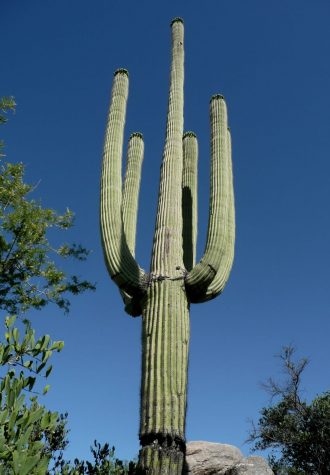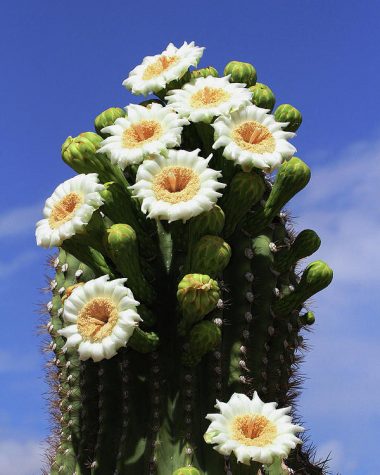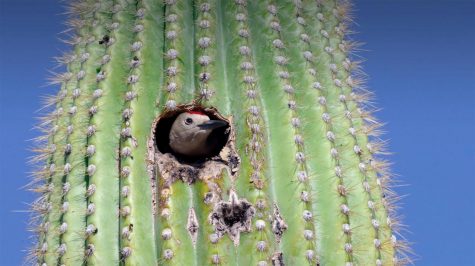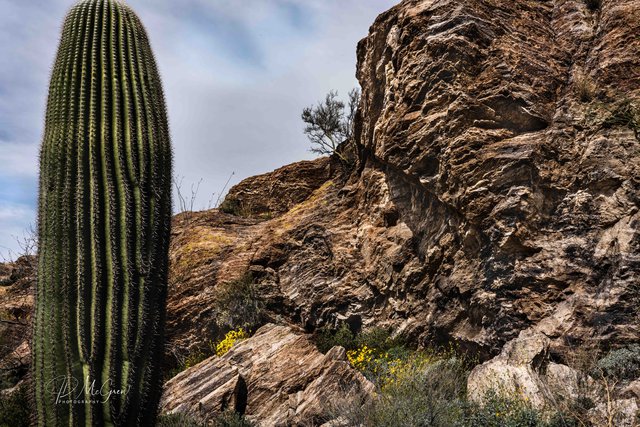The Silent Protector of Arizona
April 22, 2020
He stands at the corner of his street day and night. Tall and proud as he houses those who need shelter and protection. He smiles at anyone that passes while donning sharp armor he has worn all his life. April through June you might catch the beautiful, short lived flowers that he grows. His looks are Western Iconic. Take one look and you know his name, Saguaro.

The Saguaro is a Sonoran desert native tree-like cactus found in the Mexican State of Sonora as well as Arizona, Imperial County and Whipple Mountains of California.
The Saguaro’s milky white blossoms with yellow centers is the state wildflower of Arizona. These flowers start to bloom during late spring to early summer, blooming only at night. Every night during this time, one blossom will bloom, sharing its overripe melon scent that calls to be fertilized. If the flower is fertilized, it will grow a bright red fruit. The fruit will ripen and fall to the ground where it will crack open and expose the thousands of seeds. Many desert animals will feed off these seeds. If any seeds are spared, they may grow into saguaros one day.
The Saguaro is a western iconic cactus in most western movies and shows because of its memorable features. Unfortunately they are extremely slow growing. It can take roughly 10 years for it to grow to 1 inch and about 75-100 years to even grow one of the arms that create the recognizable forked look. As most Arizonians know, the Saguaro does not always create this iconic look. Typically they grow to around 30 feet and have 5 arms but Saguaro does not have a maximum on how many arms it can grow and some never grow arms. It is unknown why and difficult to follow as Saguaros have a bit of mystery. There is no way to find out a Saguaro’s exact age unless you know when it was planted. We do know that it can be estimated by height. At around 200 years old they could reach around 40-60 feet high and around 30 inches wide. The width though changes through the year depending on how much water it’s storing at the time. It can store upwards of 200 gallons of water. This causes the cactus to stretch its pleats, the skin of the cactus between the protective spines.
The spines of the Saguaro are sharp needle like spikes that run vertically on the cactus to protect its water. The Saguaro is a known home for many desert natives, such as the Gila Woodpecker who creates nests cavities in the pleats between the spines of the cacti. The spines protect not only the animals that call these cacti home but the Saguaros themselves. Many animals want not only to eat the the fruit the Saguaro grows but the water and tissue of the cactus. While the Saguaro is taking in the Sonoran desert sun its also housing small animals and birds and protects itself and its hosts and survive poachers.
Due to the increase in poaching, Mexico has protective laws for the cactus, and California placed Saguaros on its list of Rare and Endangered Plants for the state. It’s a no brainer why Arizona has strict laws that makes it a federal crime to cut down a Saguaro without a special permit. Even transporting it to another location and in some cases, moving them within your own land, will require a permit. Unfortunately some people do not follow the law and remove Saguaros from their homes in national and state parks as well as public lands. Saguaros are a hot commodity within the black market, especially to landscapers trying to dodge the growth wait time, permits and hefty price tags. Saguaros are sold for up to $100 per foot and the ones with arms are even more. Sadly some are damaged in the process due to incorrect removal of the cactus and roots. It can take decades to replace a stolen Saguaro or one of its arms.

So as I look up at the tall Saguaro that lives at the corner of the street with a few arms attached and homes on its pleats, I see a tall man with his arms reached for a hug, a smile on his face happy to serve as shelter and provide food.












